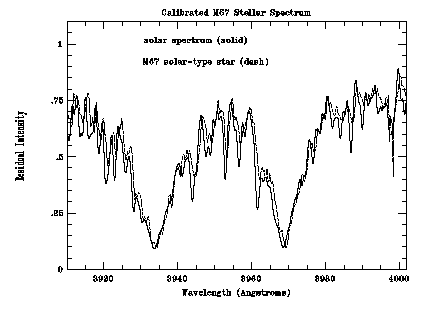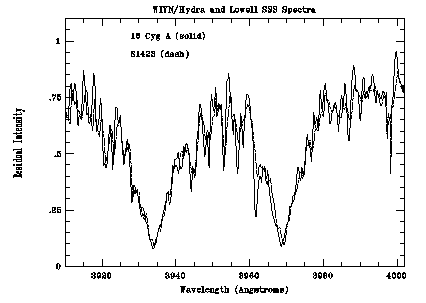
The calibration of the Hydra spectra to residual intensity and flux follows the relations given by Hall & Lockwood (1995) and Hall (1996), initially as functions of (B-V) color. These relations give the residual intensities at pseudocontinuum points at 3912 A and 4000 A, respectively, along with the continuum flux at 3950 A, each as a function of (B-V) color. We apply a correction to the relations for the 3912 and 4000 A points in order to account for the somewhat lower resolution of our Hydra spectra. The quantitative values of the correction factors are determined from the NSO solar atlas flux spectrum (Kurucz et al. 1984), degraded to match the resolution of the stellar spectra. The result of this procedure is illustrated in Figure 4 where the WIYN/Hydra spectrum of a solar-type star in M67 (S1423; V=14.38, B-V = +0.65) and the integrated spectrum of the Sun as a star are given.

FIGURE 4:The spectrum of the Sun as a star from the NSO solar flux atlas is shown along with a Hydra spectrum of a solar-type star in M67. The solar spectrum has been degraded in resolution to more closely match the Hydra spectrum. The stellar spectrum is shifted in wavelength relative to the solar spectrum due to the stellar radial velocity.
We also present in Figure 5 a comparison between this same Hydra spectrum and that of a solar analog, 16 Cyg A, as observed with the Lowell Observatory SSS instrument and kindly provided by J. Hall. In both cases, the reduction and calibration procedures yield results that are in very good agreement.

FIGURE 5:A spectrum from SSS of the solar analog 16 Cyg A, as obtained by J. Hall, is displayed along with the Hydra spectrum of a solar analog in M67. The SSS spectrum has higher spectral resolution. The spectra are slightly shifted relative to each other as a result of the differences in radial velocity. The calibration procedure yields spectra in residual flux that are in very good agreement despite the different instrumentation utilized.